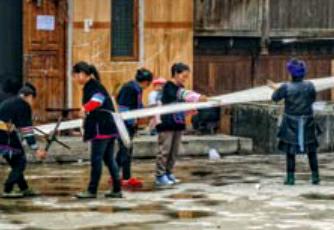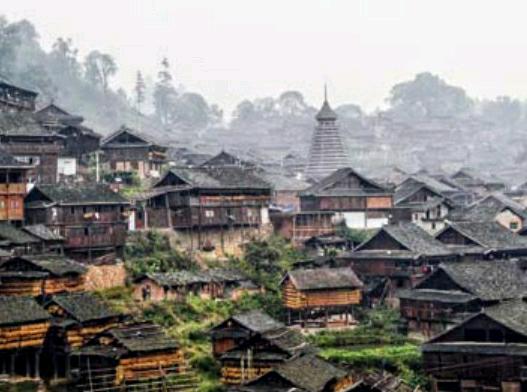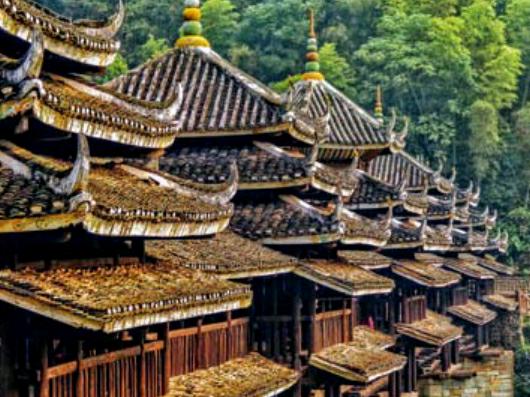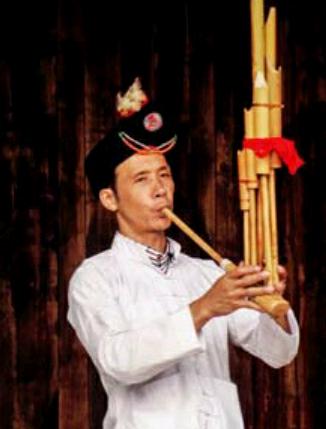Land of the Dong Minority
by+Gaetan+Reuse

A simple blurry black and white picture in a cheap book about Chinas ancient and ethnic villages was my inspiration to hop on a long and bumpy ride from Guilin to Sanjiang, a small town in northern Guangxi Zhuang Autonomous Region.
Sanjiang is the gateway to the land of the Dong, an ethnic minority with territory across southeastern Guizhou, northern Guangxi and southwestern Hunan. Like the Miao, the Dong build roofed wooden bridges known as ‘Wind and Rain Bridges(风雨桥). Unlike the Miao, the Dong also build drum towers (鼓楼), iconic of their traditional culture.
The Dong live in a relatively remote region of southwest China, but thanks to Chinas grand plan to expand highways and the high-speed rail network, many once quiet villages will undoubtedly see a major bump in tourism.
Ethnic Architecture
Near Sanjiang, the Dong hamlet cluster of Chengyang is home to the century-old Yongji Wind and Rain Bridge. After construction in 1912, the bridge was immortalized by author and poet Guo Moruo. Aside from three stone piers, everything is made of wood: reclined eaves, corridors lined with benches, verandas, a Chinese pavilion, and carefully dove-tailed beams. Yongji Bridge is one of the most representative wind-and-rain bridges and, like the drum towers, an integral piece of the Dong village landscape.
Much like wind-and-rain bridges, Dong drum towers, found in every village, are visible manifestations of Dong carpentry skills. These impressive pagoda-like wooden structures, also entirely dove-tailed and topped with a diamond-shape roof, always feature an odd number of stories, a symbol of good fortune, and are supported by sixteen pillars. The four central pillars represent the four seasons and the twelve others the twelve months of the year.
Beyond the symbolism, the drum towers also facilitate important social functions. In each village, clans built their own such structure. Because a drum tower embodies a particular clans power and wealth, the higher and the more elaborate the drum tower, the richer and more powerful the clan is perceived. In the past, a council of elders gathered in the drum tower to discuss village affairs. When rules were broken, they would determine sentences according to traditional law. After an elder beat a drum, villagers would gather to hear the council. Today, drum towers still serve as a social meeting place, usually where the villages elders play cards, drink tea, smoke, watch TV or chat around the fire.

Dong Features
Dong villages are usually nestled in valleys surrounded by forested hills. Valleys provide rich soil for rice cultivation, while forests provide villagers with various food products and timber to construct stunning bridges and drum towers.
Like most ethnic minority societies in China, the Dong group is deeply rural and agricultural. Wind-and-rain bridges were built to provide access to agricultural fields while the pillars of the drum tower symbolize months and seasons. On the Dong calendar, the 10th and 11th months bring cow fights and harvest festivals, which draw local crowds as well as increasing numbers of curious outsiders armed with cameras.
Geographic and architectural features characterize a standard Dong village. Travelers who hop from one Dong village to another will find many similarities. They are set apart by pace of tourism development and level of poverty.
Ethnic Tourism
In northern Guangxi, tourists can access the cluster of Dong hamlets of Chengyang only by paying a fee of 60 yuan. In southeastern Guizhou, the Dong village of Zhaoxing was entirely renovated and linked to the provincial capital by a highway, and non-locals must pay an admission fee of 100 yuan. In both villages, tourists can find basic accommodations, souvenir shops and organized performances to entertain busloads of tourists. Tourism provides the Dong with new sources of revenue as well as more chances to promote their culture.
South of Zhaoxing, near the town of Congjiang, Dong villages are still ‘free to visit, but that may not last if tourists start demanding more ‘authentic ethnic villages. Also under pressure would be the region of Tongdao in southwestern Hunan Province, where dozens of Dong villages with iconic drum towers and wind-and-rain bridges dot the landscape.
The cultural corridor of the Dong was once a remote region. Travelers had to endure long bus rides to reach places only a couple hours outside major urban centers, which are now serviced by expansions of high-speed rail, highway and airport networks. Conjiang and Sanjiang are connected to the high-speed rail network; Zhaoxing is a mere 45-minute drive from Liping airport, and the region of Tongdao is now integrated into highway networks.
While I was visiting the Dong region, I felt that the villages officially open to tourism (those charging admission) were better off than those untouched by tourism, which still battled poverty.
Beyond these considerations, the Dong cultural corridor in southwest China is now easier to access than ever before. Windand-rain bridges as well as the drum towers are not only iconic architectural features of Dong villages, profound manifestations of sublime carpentry skills, and remnants of traditional society – they are also assets that can be capitalized in the globalized era of ethnic tourism development.
——走进福州市鼓楼第五中心小学
China Pictorial2016年4期
